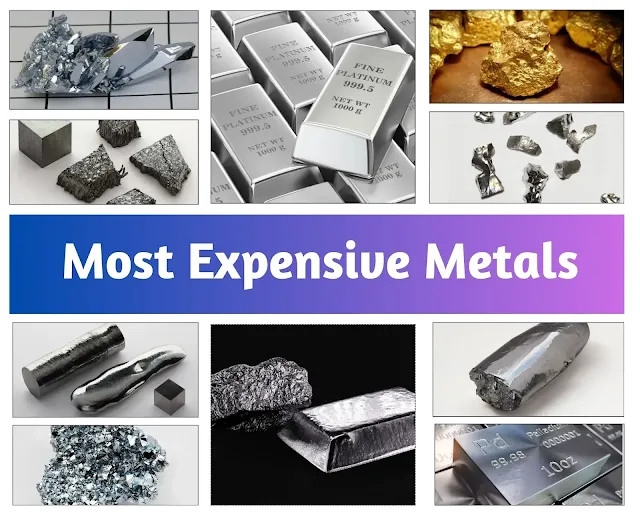Discover the Most Expensive Metal in the World: It’s Not Gold or Platinum
When we think of precious metals, gold and platinum often come to mind. However, the most expensive metal in the world is neither of these well-known elements. Precious metals, known for their rarity and high value, play a crucial role in various industries, from jewelry to advanced technology. But what exactly makes a metal precious and elevates it to the status of the world's most expensive metal?
What Makes a Metal Precious and Expensive?
The value of a precious metal is largely determined by its rarity. Unlike more common metals like iron or aluminum, precious metals exist in limited quantities, making them much more valuable. Mining these metals is often challenging and costly, which further adds to their high price.
Despite their rarity, these metals are highly practical and are essential in many industries. Their widespread applications significantly contribute to their value.
Market demand is another crucial factor in determining the price of these metals. Global demand can shift based on economic conditions, technological advancements, and industrial needs. For example, the demand for rhodium soared when stricter environmental regulations increased the need for efficient catalytic converters in vehicles.
If you are stressed read about How To Meditate Properly for Stress Reduction and Well-Being.
Platinum Group Metals: The Hidden Gems
The platinum group metals (PGMs) include osmium, ruthenium, iridium, palladium, and rhodium. While gold and silver are often the most recognized precious metals, it’s actually the platinum group metals that are the most sought after due to their remarkable properties:
- High Corrosion Resistance: These metals are exceptionally resistant to oxidation and corrosion, making them ideal for long-lasting applications.
- Catalytic Properties: Many PGMs are excellent catalysts, essential for chemical reactions.
- High Melting Points: These metals are perfect for high-temperature applications.
These unique properties make PGMs indispensable in industries like automotive, electronics, and even jewelry. Although they can symbolize luxury, PGMs are also integral to many aspects of everyday life, including the most expensive metal in the world.
Rhodium: The World's Most Expensive Metal
Rhodium, a silver-white metal from the platinum group, currently holds the title of the most expensive metal in the world. If your car has a catalytic converter, you already benefit from rhodium’s remarkable properties.
Rhodium plays a critical role in reducing toxic gas emissions and pollutants, making it essential for the global automotive industry, which consumes nearly 80% of the world’s rhodium supply. The metal’s high demand, coupled with its limited availability, makes rhodium the most valuable metal on the planet.
South Africa leads the world in rhodium production, contributing about 80% of the global supply. The metal is often found in ores mixed with other platinum group metals, requiring extensive processing to extract. Russia and Canada also produce rhodium, but their output is significantly lower.
Other Highly Valuable Precious Metals
While rhodium tops the list as the most expensive metal, several other precious metals are also highly valuable due to their unique properties and limited availability. Here are five other metals that command high prices:
Iridium: Known for its exceptional resistance to corrosion, even at high temperatures, iridium is incredibly durable. However, its hardness makes it challenging to work with. Iridium is primarily used in high-temperature applications like spark plugs and crucibles, and is mined in South Africa and Russia.
Osmium: This bluish-white metal is the densest naturally occurring element on Earth. Osmium is valuable for specialized applications like electrical contacts and fountain pen tips. It is mainly found in regions like the Urals, North America, and South America.
Gold: Perhaps the most famous of all precious metals, gold is valued for its historical significance, cultural importance, and various applications. Gold is widely used in jewelry, electronics, and as an investment asset, symbolizing wealth and luxury.
Ruthenium: A member of the platinum group, ruthenium is commonly used in the electronics industry, particularly in chip resistors. It is also used in the chemical industry to coat anodes in electrochemical cells. Ruthenium is mined primarily in North and South America.
Rhenium: Valued for its use in high-temperature superalloys, rhenium is crucial in the aerospace industry. These superalloys are used in jet engines, where they must withstand extreme conditions. Rhenium is mainly produced in the USA, Chile, Canada, and Russia.
Why Expensive Metals Matter
Understanding the significance of precious metals and their applications sheds light on why they are so valuable. From automotive and electronics to aerospace and beyond, these metals play a crucial role in various industries. While rhodium may be the most expensive metal in the world, each of these metals is indispensable in facilitating modern life. Far from being mere status symbols, these metals are essential in our electronic age.

